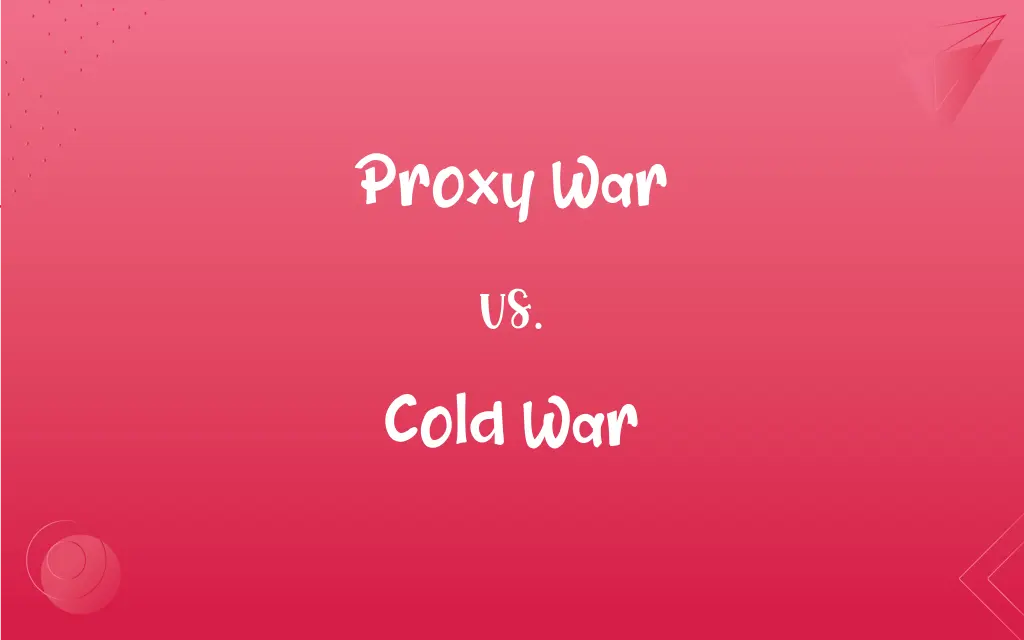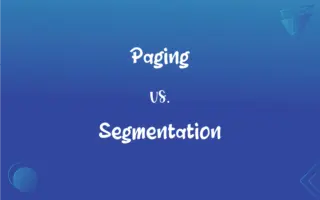Proxy War vs. Cold War: What's the Difference?
Edited by Aimie Carlson || By Harlon Moss || Updated on October 21, 2023
A proxy war involves major powers using third parties to fight on their behalf, while a cold war is a state of political tension and rivalry without direct military conflict.

Key Differences
A proxy war represents a situation where two or more major powers instigate or support other parties, often smaller states or non-state actors, to fight on their behalf. This allows the major powers to exert influence or achieve strategic objectives without directly confronting each other in battle. On the other hand, a cold war, while also marked by a lack of direct military conflict between major powers, is characterized by intense political, ideological, and economic rivalry.
During the Cold War period between the U.S. and the Soviet Union, both superpowers engaged in numerous proxy wars in different parts of the world. While the U.S. and the USSR never clashed militarily in a full-scale manner, they supported opposing sides in conflicts in places like Korea, Vietnam, and Afghanistan. The goal was often to spread or curtail the influence of communism or capitalism.
In a proxy war, the warring factions are typically equipped, funded, or otherwise supported by larger powers. These larger powers remain, to some extent, behind the scenes, allowing the proxy entities to be the primary combatants. In contrast, during a cold war, tactics like espionage, propaganda, and economic sanctions are frequently employed, but open warfare between the major powers involved is carefully avoided.
It's vital to recognize that while all proxy wars can be seen as a component or symptom of a cold war, not all cold wars will necessarily result in proxy wars. A cold war highlights the overarching tension and rivalry, while a proxy war refers to the specific, indirect conflicts that might emerge within that tense environment.
Comparison Chart
Definition
Conflict instigated by major powers but fought by third parties.
Period of political tension without direct military conflict.
ADVERTISEMENT
Key Features
Indirect engagement, third-party combatants.
Espionage, propaganda, economic sanctions.
Historical Context
Used by superpowers to exert influence without direct conflict.
Notably between U.S. and USSR post-WWII.
Major Tactics
Funding, arming, or supporting third-party fighters.
Avoiding direct conflict, promoting ideology.
Examples
U.S. and USSR supporting opposing sides in Vietnam.
U.S. and USSR rivalry post-WWII until 1991.
Proxy War and Cold War Definitions
Proxy War
A method for superpowers to exert influence indirectly.
During the 20th century, several proxy wars took place as part of global power plays.
ADVERTISEMENT
Cold War
A period of political and ideological tension without direct conflict.
The cold war between the U.S. and USSR lasted for decades.
Proxy War
Indirect warfare with major powers behind the scenes.
Major powers often use proxy wars to achieve strategic objectives without direct conflict.
Cold War
Time of strained relations without direct military battles.
The cold war saw the rise of the nuclear arms race.
Proxy War
Battles where larger entities remain largely unseen.
Many feared that the Syrian conflict might evolve into a larger proxy war.
Cold War
Intense rivalry without actual warfare between major powers.
Espionage was a key feature of the cold war era.
Proxy War
Combat fueled by bigger powers but fought by proxies.
The proxy war in Afghanistan saw the U.S. and USSR backing different factions.
Cold War
Diplomatic standoff with underlying threats of warfare.
During the cold war, the threat of nuclear annihilation loomed large.
Proxy War
Conflict where major powers support third parties to fight.
The Vietnam War was a significant proxy war during the Cold War era.
Cold War
An era marked by political posturing and propaganda.
The space race was a significant component of the cold war competition.
FAQs
Can a cold war lead to a proxy war?
Yes, during a cold war, tensions can result in proxy wars in different regions.
How does a cold war differ from traditional warfare?
A cold war involves political and ideological tension without direct military conflict.
What is a proxy war?
A proxy war is a conflict where major powers use third parties to fight on their behalf.
Why would nations engage in proxy wars?
To exert influence or achieve objectives without risking direct conflict.
How did the cold war impact global politics?
The cold war shaped alliances, fueled arms races, and influenced global events for decades.
Can there be multiple proxy wars within a cold war?
Yes, as seen during the U.S.-USSR cold war with multiple regional conflicts.
Were there any proxy wars during the U.S.-USSR cold war?
Yes, conflicts like the Vietnam War and the Soviet-Afghan War were proxy wars.
Was the space race part of the cold war?
Yes, the space race was a form of cold war competition between the U.S. and USSR.
Is a cold war always global in scope?
No, cold wars can be regional, but the U.S.-USSR cold war had global implications.
Why are proxy wars controversial?
They can escalate conflicts and cause civilian casualties, often with major powers avoiding direct blame.
Do proxy wars involve direct intervention from major powers?
Typically, major powers indirectly influence proxy wars, often through support and resources.
Can a cold war turn into a direct war?
While possible, the primary characteristic of a cold war is the absence of direct military conflict between major powers.
Did the cold war end with the dissolution of the USSR?
The U.S.-USSR cold war ended around the time of the USSR's dissolution in 1991.
Can economic sanctions be a tool in a cold war?
Yes, economic sanctions can be used to exert pressure without resorting to warfare.
Were nuclear weapons a factor in proxy wars?
While nuclear threats loomed during the cold war, proxy wars usually involved conventional warfare.
Did the U.N. play a role during the cold war era?
Yes, the U.N. often attempted to mediate tensions, though it faced challenges due to superpower rivalries.
How did propaganda play a role in the cold war?
Propaganda was used by both sides to promote ideologies and discredit opponents.
Who typically fights in a proxy war?
Smaller states or non-state actors, supported by larger powers.
How do proxy wars impact local populations?
Proxy wars can lead to casualties, displacement, and long-term instability in the regions they occur.
Do proxy wars resolve the tensions behind them?
Not necessarily; they might address regional issues but can also perpetuate or exacerbate broader tensions.
About Author
Written by
Harlon MossHarlon is a seasoned quality moderator and accomplished content writer for Difference Wiki. An alumnus of the prestigious University of California, he earned his degree in Computer Science. Leveraging his academic background, Harlon brings a meticulous and informed perspective to his work, ensuring content accuracy and excellence.
Edited by
Aimie CarlsonAimie Carlson, holding a master's degree in English literature, is a fervent English language enthusiast. She lends her writing talents to Difference Wiki, a prominent website that specializes in comparisons, offering readers insightful analyses that both captivate and inform.































































